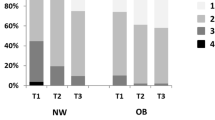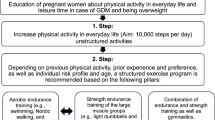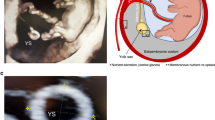Abstract
Objective:
To examine the association of physical activity on maternal–fetal circulation measured by uterine and umbilical artery Doppler flow velocimetry waveforms.
Study Design:
Participants included 781 pregnant women with Doppler ultrasounds of the uterine and umbilical artery and who self-reported past week physical activity. Linear and generalized estimating equation regression models were used to examine these associations.
Result:
Moderate-to-vigorous total and recreational activity were associated with higher uterine artery pulsatility index (PI) and an increased risk of uterine artery notching as compared with reporting no total or recreational physical activity, respectively. Moderate-to-vigorous work activity was associated with lower uterine artery PI and a reduced risk of uterine artery notching as compared with no work activity. No associations were identified with the umbilical circulation measured by the resistance index.
Conclusion:
In this epidemiologic study, recreational and work activity were associated with opposite effects on uterine artery PI and uterine artery notching, although associations were modest in magnitude.
This is a preview of subscription content, access via your institution
Access options
Subscribe to this journal
Receive 12 print issues and online access
$259.00 per year
only $21.58 per issue
Buy this article
- Purchase on Springer Link
- Instant access to full article PDF
Prices may be subject to local taxes which are calculated during checkout
Similar content being viewed by others
References
ACOG. Exercise during pregnancy and the postpartum period. ACOG Committee Opinion No. 267. 2002. Obstet Gynecol 2002; 99: 171–173.
Artal R, O’Toole M, White S . Guidelines of the American College of Obstetricians and Gynecologists for exercise during pregnancy and the postpartum period. Br J Sports Med 2003; 37: 6–12.
Dempsey J, Butler C, Williams M . No need for a pregnant pause: physical activity may reduce the occurrence of gestational diabetes mellitus and preeclampsia. Exercise Sport Sci Rev 2005; 33: 141–149.
Paisley TS, Joy EA, Price Jr RJ . Exercise during pregnancy: a practical approach. Current Sports Med Reports 2003; 2: 325–330.
Clapp III JF, Kim H, Burciu B, Schmidt S, Petry K, Lopez B . Continuing regular exercise during pregnancy: effect of exercise volume on fetoplacental growth. Am J Obstet Gynecol 2002; 186: 142–147.
Pivarnik JM, Mauer MB, Ayres NA, Kirshon B, Dildy GA, Cotton DB . Effects of chronic exercise on blood volume expansion and hematologic indices during pregnancy. Obstet Gynecol 1994; 83: 265–269.
Clapp III JF . The effects of maternal exercise on fetal oxygenation and feto-placental growth. Eur J Obstet Gynecol Reprod Biol 2003; 110 (Suppl 1): S80–S85.
Jackson MR, Gott P, Lye SJ, Ritchie JW, Clapp III JF . The effects of maternal aerobic exercise on human placental development: placental volumetric composition and surface areas. Placenta 1995; 16: 179–191.
Clapp JF . Endurance exercise and diet on human placental development and fetal growth. Placenta 2006; 27: 527–534.
Divon MY . Umbilical artery Doppler velocimetry: clinical utility in high-risk pregnancies. Am J Obstet Gynecol 1996; 174: 10–14.
Tekay A, Campbell S . Doppler ultrasonography in obstetrics In: Harrington K, Campbell S (eds). A Colour Atlas of Doppler Ultrasonography in Obstetrics. An Introduction to its Use in Maternal Fetal Medicine. Hodder Arnold Publications: London, 2000 pp 677–712.
Axt-Fliedner R, Schwarze A, Nelles I, Altgassen C, Friedrich M, Schmidt W et al. The value of uterine artery Doppler ultrasound in the prediction of severe complications in a risk population. Arch Gynecol Obstet 2005; 271: 53–58.
Bower S, Schuchter K, Campbell S . Doppler ultrasound screening as part of routine antenatal scanning: prediction of pre-eclampsia and intrauterine growth retardation. Br J Obstet Gynaecol 1993; 100: 989–994.
Aquilina J, Barnett A, Thompson O, Harrington K . Comprehensive analysis of uterine artery flow velocity waveforms for the prediction of pre-eclampsia. Ultrasound Obstet Gynecol 2000; 16: 163–170.
Coleman MA, McCowan LM, North RA . Mid-trimester uterine artery Doppler screening as a predictor of adverse pregnancy outcome in high-risk women. Ultrasound Obstet Gynecol 2000; 15: 7–12.
Irion O, Masse J, Forest JC, Moutquin JM . Prediction of pre-eclampsia, low birthweight for gestation and prematurity by uterine artery blood flow velocity waveforms analysis in low risk nulliparous women. Br J Obstet Gynaecol 1998; 105: 422–429.
Todros T, Ronco G, Fianchino O, Rosso S, Gabrielli S, Valsecchi L et al. Accuracy of the umbilical arteries Doppler flow velocity waveforms in detecting adverse perinatal outcomes in a high-risk population. Acta Obstet Gynecol Scand 1996; 75: 113–119.
Seyam YS, Al-Mahmeid MS, Al-Tamimi HK . Umbilical artery Doppler flow velocimetry in intrauterine growth restriction and its relation to perinatal outcome. Int J Gynaecol Obstet 2002; 77: 131–137.
Ertan AK, Schanz S, Tanriverdi HA, Meyberg R, Schmidt W . Doppler examinations of fetal and uteroplacental blood flow in AGA and IUGR fetuses before and after maternal physical exercise with the bicycle ergometer. J Perinat Med 2004; 32: 260–265.
Moore DH, Jarrett II JC, Bendick PJ . Exercise-induced changes in uterine artery blood flow, as measured by Doppler ultrasound, in pregnant subjects. Am J Perinatol 1988; 5: 94–97.
Steegers EA, Buunk G, Binkhorst RA, Jongsma HW, Wijn PF, Hein PR . The influence of maternal exercise on the uteroplacental vascular bed resistance and the fetal heart rate during normal pregnancy. Eur J Obstet Gynecol Reprod Biol 1988; 27: 21–26.
Erkkola RU, Pirhonen JP, Kivijarvi AK . Flow velocity waveforms in uterine and umbilical arteries during submaximal bicycle exercise in normal pregnancy. Obstet Gynecol 1992; 79: 611–615.
Kennelly MM, Geary M, McCaffrey N, McLoughlin P, Staines A, McKenna P . Exercise-related changes in umbilical and uterine artery waveforms as assessed by Doppler ultrasound scans. Am J Obstet Gynecol 2002; 187: 661–666.
Morrow RJ, Ritchie JW, Bull SB . Fetal and maternal hemodynamic responses to exercise in pregnancy assessed by Doppler ultrasonography. Am J Obstet Gynecol 1989; 160: 138–140.
Rafla NM, Etokowo GA . The effect of maternal exercise on uterine artery velocimetry waveforms. J Obstet Gynaecol 1998; 18: 14–17.
Rafla NM . Umbilical artery flow velocity waveforms following maternal exercise. J Obstet Gynaecol 1999; 19: 385–389.
Evenson KR and Wen F . Measuring physical activity in pregnant women using a structured one-week recall questionnaire: evidence for validity and reliability. Intl J Behavioral Nutr Physical Activity 2010; 7: 21. Available at http://www.ijbnpa.org/content/7/1/21.
Borg G, Linderholm H . Perceived exertion and pulse rate during graded exercise in various age groups. Acta Med Scand 1974; 472: 194–206.
Ainsworth BE, Haskell WL, Herrmann SD, Meckes N, Bassett Jr DR, Tudor-Locke C et al. 2011 Compendium of physical activities: a second update of codes and MET values. Med Sci Sports Exerc 2011; 43: 1575–1581.
Affairs AMACoS. Summaries and recommendations of Council on Scientific Affairs Reports: 1999 AMA Annual Meeting. Effects of Work on Pregnancy 1999, Accessed 7 November 2011 at http://www.ama-assn.org/ama1/pub/upload/mm/443/csaa-99.pdf.
Pollock M, Gaesser G, Butcher J, Despres J, Dishman R, Franklin B et al. American College of Sports Medicine Position Stand: the recommended quantity and quality of exercise for developing and maintaining cardiorespiratory and muscular fitness, and flexibility in healthy adults. Med Sci Sport Exer 1998; 30: 975–991.
Proctor B, Dalaker J . US Bureau of the Census, Current Population Reports. Series P 60-219 US Government Printing Office: Washington, DC, 2002.
Institute of Medicine. Nutrition During Pregnancy: Part I, Weight Gain; Part II Nutrient Supplements. Committee on Nutritional Status During Pregnancy and Lactation, Food and Nutrition Board, National Academy Press: Washington, DC, 1990.
Kleinbaum D, Kupper L, Muller K, Nizam A . Applied Regression Analysis and Other Multivariable Methods. 3rd edn Duxbury Press: Pacific Grove, CA, 1998.
Diggle P, Heagerty P, Liang K, Zeger S . Analysis of Longitudinal Data. 2nd edn Oxford University Press: Oxford, 2002.
Carbillon L, Challier JC, Alouini S, Uzan M, Uzan S . Uteroplacental circulation development: Doppler assessment and clinical importance. Placenta 2001; 22: 795–799.
Bergmann A, Zygmunt M, Clapp III JF . Running throughout pregnancy: effect on placental villous vascular volume and cell proliferation. Placenta 2004; 25: 694–698.
Acknowledgements
This study was funded by the following grants: National Institutes of Health (NIH)/National Institute of Child Health and Human Development #HD37584, NIH/General Clinical Research Center #RR00046 and NIH/National Cancer Institute #R01CA109804. Dr Nguyen was funded in part by a grant from the Vietnam Education Foundation (VEF). The content is solely the responsibility of the authors and does not necessarily represent the official views of the NIH or VEF. The Pregnancy, Infection and Nutrition Study, along with the ancillary projects, is a joint effort of many investigators and staff members whose work is gratefully acknowledged.
Author information
Authors and Affiliations
Corresponding author
Ethics declarations
Competing interests
The authors declare no conflict of interest.
Rights and permissions
About this article
Cite this article
Nguyen, N., Evenson, K., Savitz, D. et al. Physical activity and maternal–fetal circulation measured by Doppler ultrasound. J Perinatol 33, 87–93 (2013). https://doi.org/10.1038/jp.2012.68
Received:
Revised:
Accepted:
Published:
Issue Date:
DOI: https://doi.org/10.1038/jp.2012.68
Keywords
This article is cited by
-
Predictive accuracy of the first trimester Doppler scan: a meta-study
Wiener Medizinische Wochenschrift (2015)



